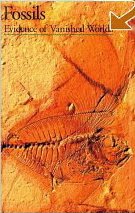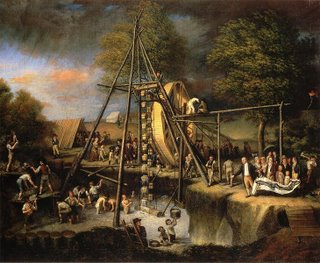Reading About Fossils

I just finished meandering through the neatest little book on fossils -- "Fossils: Evidence of Vanished Worlds". Written by the French science researcher Yvette Gayrard-Valy, translated by I. Mark Paris, and apparently last published in 1994 (but still available on amazon.com through used listings), it's not the picture book of fossils it appears. Instead, it is a compact history of paleontology packed into 192 pages of very readable text and amazing illustrations. Sort of a secular equivalent of the IVP Histories I referenced earlier, but this time about the history of the study of fossils.
The history of paleontology may sound less than fascinating to the uninitiated, but that is just not the case. Paleontology got started early enough (several hundred years ago, at least three hundred years ago in earnest) that devoted amateurs, many of them churchmen, were able to get the enterprise moving and shape its early developments. It also requires digging in the rocks in unlikely and hard-to-reach places, meaning that many of this science's most successful practitioners made Indiana Jones look more or less commonplace.
Alas, it's a modern scientific book, so it swallows whole all of modern science's assumptions about the age of the Earth, evolution and fossil creation. But it does a great service by being honest about the history of the development of these theories and approaches with real sympathy and balance the enthusiasm of early fossil experts for Biblically-based explanations of these strange creatures in the rocks. It even reproduces a beautiful cross section of the earth's crust from the Rev. William Buckland's Bridgewater Treatises on the Power, Wisdom and Goodness of God as Manifested in the Creation, which included a treatise entitled "Geology and Mineralogy Considered with Reference to Natural Theology". While the author dismisses Buckland's theories as "simplistic", at least Buckland's work receives considerable notice here.
Two special treats: First, the discussion of "glossopetrae" -- what we now know to be discarded sharks' teeth. But Pliny the Elder (who perished while watching Vesuvius erupt after taking a boat toward the volcano to observe and possibly rescue the perishing) thought they were petrified tongues that fell from the sky during lunar eclipses. The same pharmacists who ground up "horn of unicorn" (often narwhal horn) pulverized shark teeth to make a medicine for snakebite, vomiting, fever and spells. "Or a whole tooth could be worn as an amulet. Tongue-stones' reputed power to neutralize poison earned little tree-shaped tongue-stone holders a place of honor on European dining tables from the Middle Ages to the 18th century." I wonder if I can find one of those on ebay . . . .
 Second is a two-page reproduction of "The Exhumation of the Mastadon" by Charles Wilson Peale, the famous colonial American artist. In the early 1800;s, after farmer John Masten found gigantic bones on his farm in Orange County, New York, Peale leased the peat bog where Masten had found the bones and found his own mastodon skeleton after draining the bog using the apparatus shown in the painting. What better way to celebrate the find than with this painting, which hangs today in The Peale Museum in Baltimore?
Second is a two-page reproduction of "The Exhumation of the Mastadon" by Charles Wilson Peale, the famous colonial American artist. In the early 1800;s, after farmer John Masten found gigantic bones on his farm in Orange County, New York, Peale leased the peat bog where Masten had found the bones and found his own mastodon skeleton after draining the bog using the apparatus shown in the painting. What better way to celebrate the find than with this painting, which hangs today in The Peale Museum in Baltimore?
OK, so I like fossils. I even have a foot bone from a mammoth that I found in Texas. No, really, I do. I'll have to post a picture or something.

I just finished meandering through the neatest little book on fossils -- "Fossils: Evidence of Vanished Worlds". Written by the French science researcher Yvette Gayrard-Valy, translated by I. Mark Paris, and apparently last published in 1994 (but still available on amazon.com through used listings), it's not the picture book of fossils it appears. Instead, it is a compact history of paleontology packed into 192 pages of very readable text and amazing illustrations. Sort of a secular equivalent of the IVP Histories I referenced earlier, but this time about the history of the study of fossils.
The history of paleontology may sound less than fascinating to the uninitiated, but that is just not the case. Paleontology got started early enough (several hundred years ago, at least three hundred years ago in earnest) that devoted amateurs, many of them churchmen, were able to get the enterprise moving and shape its early developments. It also requires digging in the rocks in unlikely and hard-to-reach places, meaning that many of this science's most successful practitioners made Indiana Jones look more or less commonplace.
Alas, it's a modern scientific book, so it swallows whole all of modern science's assumptions about the age of the Earth, evolution and fossil creation. But it does a great service by being honest about the history of the development of these theories and approaches with real sympathy and balance the enthusiasm of early fossil experts for Biblically-based explanations of these strange creatures in the rocks. It even reproduces a beautiful cross section of the earth's crust from the Rev. William Buckland's Bridgewater Treatises on the Power, Wisdom and Goodness of God as Manifested in the Creation, which included a treatise entitled "Geology and Mineralogy Considered with Reference to Natural Theology". While the author dismisses Buckland's theories as "simplistic", at least Buckland's work receives considerable notice here.
Two special treats: First, the discussion of "glossopetrae" -- what we now know to be discarded sharks' teeth. But Pliny the Elder (who perished while watching Vesuvius erupt after taking a boat toward the volcano to observe and possibly rescue the perishing) thought they were petrified tongues that fell from the sky during lunar eclipses. The same pharmacists who ground up "horn of unicorn" (often narwhal horn) pulverized shark teeth to make a medicine for snakebite, vomiting, fever and spells. "Or a whole tooth could be worn as an amulet. Tongue-stones' reputed power to neutralize poison earned little tree-shaped tongue-stone holders a place of honor on European dining tables from the Middle Ages to the 18th century." I wonder if I can find one of those on ebay . . . .
 Second is a two-page reproduction of "The Exhumation of the Mastadon" by Charles Wilson Peale, the famous colonial American artist. In the early 1800;s, after farmer John Masten found gigantic bones on his farm in Orange County, New York, Peale leased the peat bog where Masten had found the bones and found his own mastodon skeleton after draining the bog using the apparatus shown in the painting. What better way to celebrate the find than with this painting, which hangs today in The Peale Museum in Baltimore?
Second is a two-page reproduction of "The Exhumation of the Mastadon" by Charles Wilson Peale, the famous colonial American artist. In the early 1800;s, after farmer John Masten found gigantic bones on his farm in Orange County, New York, Peale leased the peat bog where Masten had found the bones and found his own mastodon skeleton after draining the bog using the apparatus shown in the painting. What better way to celebrate the find than with this painting, which hangs today in The Peale Museum in Baltimore?OK, so I like fossils. I even have a foot bone from a mammoth that I found in Texas. No, really, I do. I'll have to post a picture or something.


1 Comments:
I didn't know that narwhals were real.!!!
Post a Comment
<< Home